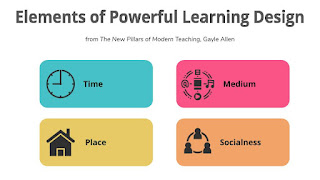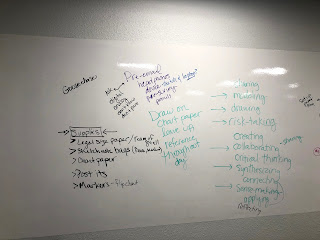Over the past few years, I've been reflecting on my own learning preferences, which leads me to consider how I design professional learning for others.
(Yes, the ABBA song "Knowing Me Knowing You" inspired the title of this post, but these reflections aren't too much about a breakup! Feel free to listen to the song as you read along. 😄)
I first shared the Elements of Powerful Learning Design in this post in 2019, and because of the pandemic, I changed my views about using video and YouTube for learning. In this post, I reflected on what I learned during 2020 related to designing professional learning.
Bottom line: preferences change. I'm writing this post in August, which means the beginning of a new school year, so I think it's a good time to think again about my own learning preferences and how I might use these understandings to design purposeful professional development for others.
In The New Pillars of Modern Teaching (mentioned many times in this blog) Gayle created these categories as the Elements of Powerful Learning Design: time, place, medium, and socialness.
Knowing me: reflecting on my own learning preferences
As you read, I encourage you to grab a sticky note and reflect on your own learning preferences because, like me, your preferences may have changed during the pandemic.
Here are a few questions to reflect on your own preferences. (Answer on your sticky note!)
- How much time do you like to spend learning? Do you like short bursts of time, like TikTok videos, quick blog posts, or fast-paced Twitter chats? Or do you prefer extended conferences or courses or long-form reads? What is your ideal time of day to learn? Are you an owl (evening person) or a lark (morning person)? My time preferences remain the same as pre-pandemic; I look for longer stretches of learning held early in the day.
- In what place do you want to learn? The place could mean online or face-to-face. It could also mean in a classroom, coffee shop, or on a couch. This area is one that really changed for me during 2020-'21. I used to prefer a more "formal" setting, but now I want to learn at home, on my couch.
- What is your preferred learning medium? I feel this category is the one we think about first (text, audio, video, images) but it's not the only category. I still rate myself as a text-first kind of person, and I'm now consuming a lot more books than in recent years. I still love to find small learning nuggets from listening to podcasts. But because of the pandemic, I also have a new appreciation for videos, especially when I can change the video speed.
- What level of socialness do you need in your learning experiences? My preference has always been to work with one or two thinking partners, and this category was the one that was sometimes absent during the pandemic. I knew (from my love for the online course #ClassyGraphics) that virtual, asynchronous collaboration worked for me. And from 2020-'21, I learned that I can collaborate via Zoom just as well (or almost as well) as face-to-face. I noticed the lack of socialness during multi-day, online events. I hopped from one virtual session to the next, participated somewhat in the chats, but I missed session debriefs, hallway conversations, or other types of post-event sharing. (Note to self: embed socialness into future online events!)
If you understood your own learning preferences prior to 2020, did anything change this year? Which one of the preferences is your priority when you design your own learning? For me (and maybe that's because of pandemic times) I'm willing to choose a
social learning event, even if the time and medium do not meet my preferences.
Knowing you: designing purposeful professional learning for others
As I wrote in the previous learning preferences posts, I know that when I created professional learning for others, I sometimes leaned into designing for my own preferences. I think that strategy is OK-ish because I want to develop PD that I would want to attend.
What makes understanding the four elements of learning design (time, place, medium, and socialness) powerful is when I design PD with these categories in mind, I create opportunities for choice and voice.
One of the "wins" for our organization in 2020-'21 was that the consultants created many sessions in a variety of formats. During the past summer, our participants could learn by attending 1-hour webinars, 3- or 6- hour live sessions; short asynchronous sessions, long self-paced online classes, and collaborative book studies. Our participants had so much choice with the time of day and length of time of their sessions. They could attend in virtual or "real" places. In all sessions, the socialness varied, from collaborating in the Zoom chat or breakout rooms to working in small groups when face-to-face. For medium, our sessions across the organization included (original and found) content from videos, podcasts, books, blogs, and tweets. Participants also had options in their output, i.e. how they demonstrated their learning.
If my sessions did not meet others' preferences, I was not too worried because there were so many other formats and choices available. But designing professional learning to meet the needs of my audience is an area of growth for me, and by capturing these reflections, I hope I'm more cognizant of when my own preferences overtake the PD sessions I create.
One solution comes from my friend Julianna, who is an Instructional Designer on my team. She (mostly) creates online courses, and before she begins designing a new course, she develops a "character" for the class, i.e. a typical course participant, and keeps that educator in mind as she designs the work.
Another adjustment I've made is to be more transparent in the session description about the purpose, expectations, and format of the session. (This idea comes from concepts in the book
The Art of Gathering.) At the beginning of the pandemic, I know participants left the session as soon as I opened Zoom breakout rooms because they were not feeling social...and that's OK! As Priya Parker discusses in her book, the event begins "at the moment of discovery," which for me means when someone reads the session description. I now include phrases like "collaborate in breakout rooms," or "independently reflect on resources" to give potential participants a better idea of what's in store for the session.
And that type of information helps others take ownership of their own learning, too!
Informed to Transform
During the start of the pandemic in 2020, my colleague Laura and I created a podcast series called
From Triage to Transformation, and we considered how learning might be transformed post-pandemic. Here's one episode where the focus was learning design for educators.
We analyze our own favorite learning experiences based on time, place, medium, and socialness, and in this episode, Laura asks,
How do we take our best learning experiences to inform and transform the design of what we're building?
When I understand my own preferences (knowing me) I am able to broaden my scope of how I design for others (knowing you).
Always learning.


